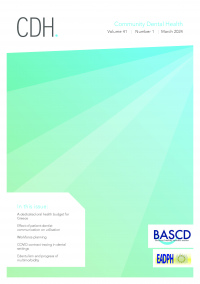June 2017
Factors affecting dental fluorosis in low socioeconomic status children in Mexico
Abstract
Objective: To assess the association between dental fluorosis and maternal education in schoolchildren of medium and low socioeconomic status in a low income region of Mexico. Design: Cross-sectional study. Settings: Public schools in the south-central region of Oaxaca, Mexico where the mean fluoride water concentration was 1.01 mg/L (SD 0.21; range 0.71-1.40). Fluoridated salt (200mgF/kg) was available in the region. Participants: 794 schoolchildren. Methods: To identify the socioeconomic status of the participants, the Bronfman index was used. Dental fluorosis was assessed applying the Thysltrup-Fejerskov Index, (TF). Results: The children’s mean age was 10.4 (SD 1.2) years. The prevalence of dental fluorosis (TF>0) was high 95.7% and 45.2% of the children showed dental fluorosis of TF≥4. The percentage of children showing TF≥4 was 48.8% where their mothers’ education was <6 years of schooling compared to 36.7% among other children (p<0.001). The multinomial logistic regression model using as base outcome category TF≤2 showed that severe forms of fluorosis (TF≥4) were associated with the consumption of boiled water, (OR= 1.65, p=0.039) of fluoridated salt (OR= 2.61 p=0.001), high brushing frequency (OR=3.12, p=0.001) and lower maternal education (OR=1.71, p=0.007). Conclusions: A high prevalence of dental fluorosis was observed in the study region. An unequal burden of fluorosis in aesthetically objectionable categories was found in children exposed to several sources of fluoride and whose mother had lower educational level. Key words: dental fluorosis, socioeconomic factors, maternal education, schoolchildren, public dental health, México




